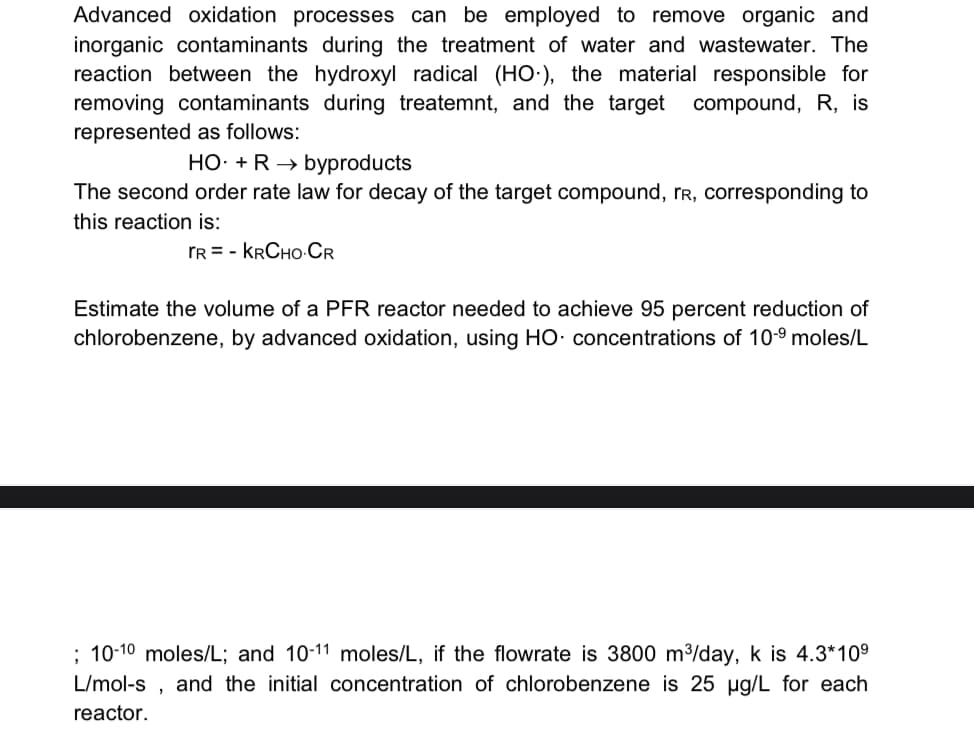Advanced oxidation processes can be employed to remove organic and inorganic contaminants during the treatment of water and wastewater. The reaction between the hydroxyl radical (HO), the material responsible for removing contaminants during treatemnt, and the target compound, R, is represented as follows: HO. + R → byproducts The second order rate law for decay of the target compound, rR, corresponding to this reaction is: TR KRCHO-CR Estimate the volume of a PFR reactor needed to achieve 95 percent reduction of chlorobenzene, by advanced oxidation, using HO concentrations of 10-9 moles/L ; 10-10 moles/L; and 10-11 moles/L, if the flowrate is 3800 m³/day, k is 4.3*10⁹ L/mol-s and the initial concentration of chlorobenzene is 25 µg/L for each reactor.
Advanced oxidation processes can be employed to remove organic and inorganic contaminants during the treatment of water and wastewater. The reaction between the hydroxyl radical (HO), the material responsible for removing contaminants during treatemnt, and the target compound, R, is represented as follows: HO. + R → byproducts The second order rate law for decay of the target compound, rR, corresponding to this reaction is: TR KRCHO-CR Estimate the volume of a PFR reactor needed to achieve 95 percent reduction of chlorobenzene, by advanced oxidation, using HO concentrations of 10-9 moles/L ; 10-10 moles/L; and 10-11 moles/L, if the flowrate is 3800 m³/day, k is 4.3*10⁹ L/mol-s and the initial concentration of chlorobenzene is 25 µg/L for each reactor.
Materials Science And Engineering Properties
1st Edition
ISBN:9781111988609
Author:Charles Gilmore
Publisher:Charles Gilmore
Chapter5: Phase Transformations And Phase Diagrams
Section: Chapter Questions
Problem 5.11P
Related questions
Question
Show solution with a diagram

Transcribed Image Text:Advanced oxidation processes can be employed to remove organic and
inorganic contaminants during the treatment of water and wastewater. The
reaction between the hydroxyl radical (HO), the material responsible for
removing contaminants during treatemnt, and the target compound, R, is
represented as follows:
HO. + R → byproducts
The second order rate law for decay of the target compound, rR, corresponding to
this reaction is:
TR KRCHO-CR
Estimate the volume of a PFR reactor needed to achieve 95 percent reduction of
chlorobenzene, by advanced oxidation, using HO concentrations of 10-9 moles/L
; 10-10 moles/L; and 10-11 moles/L, if the flowrate is 3800 m³/day, k is 4.3*10⁹
L/mol-s and the initial concentration of chlorobenzene is 25 µg/L for each
reactor.
Expert Solution
This question has been solved!
Explore an expertly crafted, step-by-step solution for a thorough understanding of key concepts.
Step by step
Solved in 4 steps with 4 images

Follow-up Questions
Read through expert solutions to related follow-up questions below.
Follow-up Question
Could you please explain how we got this integration equation , and why we substitute the values in the underlined part and what they stand for ?
![Given,
Molecular weight of chlorobenzene = 112.56 g/mol
R+ chlorobenzene = 25 μg/l
{ in all 3 reactors}
Molor Concentration of R
251g/l
112-56 g/mol
Cro = 0.22x15² mollet
Concentration of Ho in all 3 reactor : Cao
10 molled
→ 100 mollet
10" mollet
Volumetric flow rate
ری دارد
second order rate low:
V
1
VR
кр сно ср = ra
K≤ 4-3 x 189 llnd-see
= CA
109
S-
0.95
S
109
= 25 ug/l { in all
vatansy alt
For 951. Conversion, XAS =0.95 79 slov
ход
S s dxA
less
0.95
109
109 S
D
dxA
кса се
0.95
(VA)
S
= 3800 m³/day
s0.0416 m³/sec
where, CA
CR
s
10
Frustelfel loter
Asidorgyd
dxa
K CAO (XA) (Ceo CAO XA)
=
dxA
Catt
сво
KCAU (I-XA) CRO [1-(AU XA]
CRO
dx A
KCAO (RO (1-XA) (1-MYA)
stab noves
ی کو دور
(3:2) enefeodaralds
wom' al- nudushooned of
publem 0038 = etorcida
zlomil 01x8.
nodrodno je masenviros bitme
Спо-своха
Cao - CAO XA
ON
woll andscaulov
(orvoo)
yote
15-9972
word sw](https://content.bartleby.com/qna-images/question/7136435d-2c0b-4a6a-bb14-2bf831d8826c/34ec754c-49e6-4f7d-8732-13620512afad/v72xb_thumbnail.jpeg)
Transcribed Image Text:Given,
Molecular weight of chlorobenzene = 112.56 g/mol
R+ chlorobenzene = 25 μg/l
{ in all 3 reactors}
Molor Concentration of R
251g/l
112-56 g/mol
Cro = 0.22x15² mollet
Concentration of Ho in all 3 reactor : Cao
10 molled
→ 100 mollet
10" mollet
Volumetric flow rate
ری دارد
second order rate low:
V
1
VR
кр сно ср = ra
K≤ 4-3 x 189 llnd-see
= CA
109
S-
0.95
S
109
= 25 ug/l { in all
vatansy alt
For 951. Conversion, XAS =0.95 79 slov
ход
S s dxA
less
0.95
109
109 S
D
dxA
кса се
0.95
(VA)
S
= 3800 m³/day
s0.0416 m³/sec
where, CA
CR
s
10
Frustelfel loter
Asidorgyd
dxa
K CAO (XA) (Ceo CAO XA)
=
dxA
Catt
сво
KCAU (I-XA) CRO [1-(AU XA]
CRO
dx A
KCAO (RO (1-XA) (1-MYA)
stab noves
ی کو دور
(3:2) enefeodaralds
wom' al- nudushooned of
publem 0038 = etorcida
zlomil 01x8.
nodrodno je masenviros bitme
Спо-своха
Cao - CAO XA
ON
woll andscaulov
(orvoo)
yote
15-9972
word sw
Solution
Knowledge Booster
Learn more about
Need a deep-dive on the concept behind this application? Look no further. Learn more about this topic, civil-engineering and related others by exploring similar questions and additional content below.Recommended textbooks for you

Materials Science And Engineering Properties
Civil Engineering
ISBN:
9781111988609
Author:
Charles Gilmore
Publisher:
Cengage Learning


Materials Science And Engineering Properties
Civil Engineering
ISBN:
9781111988609
Author:
Charles Gilmore
Publisher:
Cengage Learning
